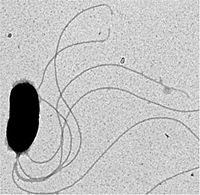Vibrio fischeri: Difference between revisions
imported>Yeong M Shin |
imported>Yeong M Shin No edit summary |
||
| Line 5: | Line 5: | ||
| color = pink | | color = pink | ||
| name = ''Vibrio fischeri'' | | name = ''Vibrio fischeri'' | ||
| image = | | image = Vibrio_Fischeri-_PNAS_2005;_102(8)_2673-4,_Figure_2.1_lores.jpg | ||
| regnum = [[Bacteria]] | | regnum = [[Bacteria]] | ||
| phylum = [[Proteobacteria]] | | phylum = [[Proteobacteria]] | ||
Revision as of 09:46, 17 April 2009
For the course duration, the article is closed to outside editing. Of course you can always leave comments on the discussion page. The anticipated date of course completion is May 21, 2009. One month after that date at the latest, this notice shall be removed. Besides, many other Citizendium articles welcome your collaboration! |
| Vibrio fischeri | ||||||||||||||
|---|---|---|---|---|---|---|---|---|---|---|---|---|---|---|
 | ||||||||||||||
| Scientific classification | ||||||||||||||
| ||||||||||||||
| Binomial name | ||||||||||||||
| Vibrio fischeri |
Description and significance
Vibrio fischeri is a curved rod shaped, motile, marine bioluminescent symbiotic bacterium found in the light organs of fish and squid. The bacterium is a heterotrophic facultative anaerobe that shows up as gram negative using the gram stain. V. fischeri bioluminesce only after reaching a certain population density. There has been much studies done on symbiotic relationship between a particular strain of V. fischeri and the Hawaiian bobtail squid, Euprymma scolopes. The nocturnal squid uses the bioluminescence bacteria as camouflage in a 'counterillumination' strategy, while the host provides housing and nutrients for the bacterium.
Genome structure
Cell structure and metabolism
Ecology
Vibrio fischeri can be found in the upper 1000m of the ocean, living freely, or amongst the mixed biota in the guts of marine animals but is more commonly found as symbionts
Pathology
Vibrio fischeri is non-pathogenic to humans but three other members of the Vibrios family are. These are; V. cholerae, V.parahaemolytus, V. vulnificus.